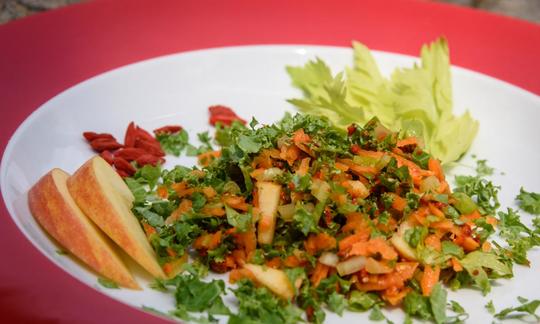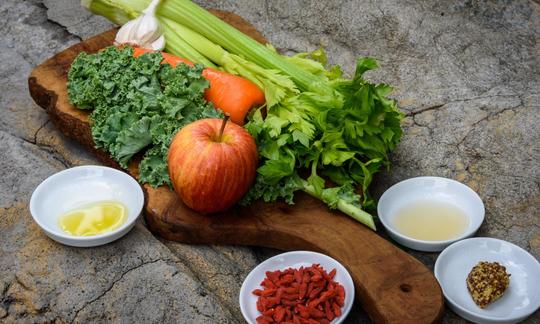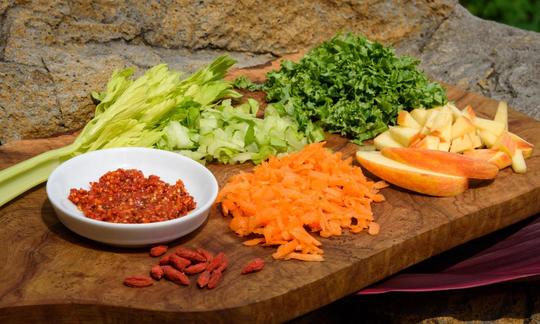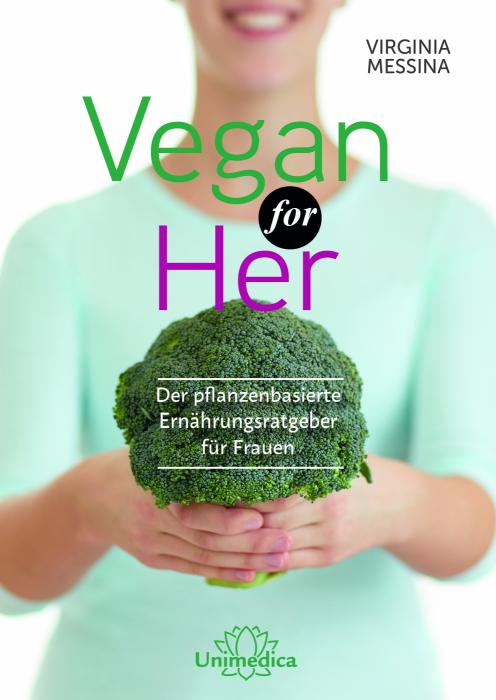Apple Slaw with Kale and Goji Berry Dressing
raw-vegan
Ingredients (for servings, )
| For the apple slaw | |
|---|---|
| 1 | Apple, raw, with peel (5.3 oz) |
| 2 | Carrots (carrots), raw (organic?) (4.3 oz) |
| 1 stalk | Celery (bleached celery), raw (organic?) (1.1 oz) |
| 3 leaves | Kale, raw (spring cabbage, organic?) (2.7 oz) |
| For the dressing | |
| 1 clove | Garlic (organic?) (0.11 oz) |
| 1 tbsp | Avocado oil (raw?, organic?) (0.49 oz) |
| 2 tbsp | Apple cider vinegar (raw?, organic?) (1.0 oz) |
| 1 tsp | Mustard (Mostert, Mostrich, raw?, organic?) (0.18 oz) |
| 1 oz | Goji berries, dried, (organic?) |
| 60 ml | Drinking water, raw (organic?) (2.1 oz) |
| Seasoning | |
| 1 dash | Black pepper (organic?, raw?) (0.00 oz) |
Equipment
- food processor or mezzaluna
- blender
- refrigerator
Type of preparation
- chop or grind
- food preparation without heating
- meld
- season to taste
- purée
- remove the skin
Preparation
For the apple slaw
Wash and quarter the apple and then remove the core (peeling is not necessary). Clean the carrots, celery, and kale and then finely chop, along with the apple, in a food processor (cutting blade) or using a mezzaluza.Transfer the mixture to a large bowl.
The original recipe calls for a large apple, large carrots, and a large stalk of celery.
As you can leave the apple unpeeled, it is best to select an organic variety.
For the dressing
Peel the garlic clove and place in a food processor or blender along with the other ingredients for the dressing (oil, apple cider vinegar, mustard, and goji berries) and 60 ml water. Purée until smooth.The amount of water (60 ml) is for the recipe that makes 4 servings.
If you don’t have or want to use avocado oil, Virginia Messina recommends that you use extra virgin olive oil.
The original recipe actually calls for coarse ground mustard. You can also use our variation.
Dressing the salad
Pour a generous amount of the dressing over the apple slaw and then gently toss.Place in an air-tight container and refrigerate for at least 30 minutes to let the flavors meld.
Seasoning and serving
Just before serving, season liberally with black pepper and mix well.
|
Nutritional Information per person
Convert per 100g
|
2000 kcal | |
|---|---|---|
| Energy | 103 kcal | 5.2% |
| Fat/Lipids | 4.1 g | 5.8% |
| Saturated Fats | 0.45 g | 2.3% |
| Carbohydrates (inc.dietary fiber) | 16 g | 6.0% |
| Sugars | 9.4 g | 10.4% |
| Fiber | 3.6 g | 14.5% |
| Protein/Albumin | 2.4 g | 4.9% |
| Cooking Salt (Na:72.1 mg) | 183 mg | 7.6% |
| Essential micronutrients with the highest proportions | per person | 2000 kcal | |
|---|---|---|---|
| Vit | Vitamin K | 146 µg | 195.0% |
| Vit | Vitamin A, as RAE | 456 µg | 57.0% |
| Min | Copper, Cu | 0.41 mg | 41.0% |
| Vit | Vitamin C (ascorbic acid) | 31 mg | 39.0% |
| Vit | Vitamin B9, B11 (Folate, as the active form of folic acid) | 37 µg | 19.0% |
| Elem | Potassium, K | 346 mg | 17.0% |
| Min | Manganese, Mn | 0.29 mg | 15.0% |
| Vit | Vitamin E, as a-TEs | 1.6 mg | 13.0% |
| Prot | Threonine (Thr, T, irreversibly transaminated) | 0.09 g | 10.0% |
| Sodium, Na | 72 mg | 9.0% | |
Detailed Nutritional Information per Person for this Recipe
The majority of the nutritional information comes from the USDA (US Department of Agriculture). This means that the information for natural products is often incomplete or only given within broader categories, whereas in most cases products made from these have more complete information displayed.
If we take flaxseed, for example, the important essential amino acid ALA (omega-3) is only included in an overarching category whereas for flaxseed oil ALA is listed specifically. In time, we will be able to change this, but it will require a lot of work. An “i” appears behind ingredients that have been adjusted and an explanation appears when you hover over this symbol.
For Erb Muesli, the original calculations resulted in 48 % of the daily requirement of ALA — but with the correction, we see that the muesli actually covers >100 % of the necessary recommendation for the omega-3 fatty acid ALA. Our goal is to eventually be able to compare the nutritional value of our recipes with those that are used in conventional western lifestyles.
| Essential fatty acids | per person | 2000 kcal |
|---|---|---|
| Linoleic acid; LA; 18:2 omega-6 | 0.53 g | 5.0% |
| Alpha-Linolenic acid; ALA; 18:3 omega-3 | 0.08 g | 4.0% |
| Essential amino acids | per person | 2000 kcal |
|---|---|---|
| Threonine (Thr, T, irreversibly transaminated) | 0.09 g | 10.0% |
| Isoleucine (Ile, I) | 0.05 g | 4.0% |
| Leucine (Leu, L) | 0.08 g | 3.0% |
| Lysine (Lys, K, irreversibly transaminated) | 0.06 g | 3.0% |
| Phenylalanine (Phe, F) | 0.05 g | 3.0% |
| Valin (Val, V) | 0.06 g | 3.0% |
| Tryptophan (Trp, W) | 0.00 g | 2.0% |
| Methionine (Met, M) | 0.02 g | 2.0% |
| Vitamins | per person | 2000 kcal |
|---|---|---|
| Vitamin K | 146 µg | 195.0% |
| Vitamin A, as RAE | 456 µg | 57.0% |
| Vitamin C (ascorbic acid) | 31 mg | 39.0% |
| Vitamin B9, B11 (Folate, as the active form of folic acid) | 37 µg | 19.0% |
| Vitamin E, as a-TEs | 1.6 mg | 13.0% |
| Vitamin B6 (pyridoxine) | 0.13 mg | 9.0% |
| Vitamin B7 (Biotin, ex vitamin H) | 3.4 µg | 7.0% |
| Vitamin B1 (Thiamine) | 0.05 mg | 5.0% |
| Vitamin B2 (Riboflavin) | 0.06 mg | 4.0% |
| Vitamin B3 (Niacin) | 0.57 mg | 4.0% |
| Vitamin B5 (Pantothenic acid) | 0.15 mg | 3.0% |
| Essential macroelements (macronutrients) | per person | 2000 kcal |
|---|---|---|
| Potassium, K | 346 mg | 17.0% |
| Sodium, Na | 72 mg | 9.0% |
| Calcium, Ca | 62 mg | 8.0% |
| Phosphorus, P | 52 mg | 7.0% |
| Magnesium, Mg | 21 mg | 6.0% |
| Essential trace elements (micronutrients) | per person | 2000 kcal |
|---|---|---|
| Copper, Cu | 0.41 mg | 41.0% |
| Manganese, Mn | 0.29 mg | 15.0% |
| Iron, Fe | 1.00 mg | 7.0% |
| Zinc, Zn | 0.38 mg | 4.0% |
| Selenium, Se | 0.80 µg | 1.0% |
| Iod, I (Jod, J) | 1.3 µg | 1.0% |
| Fluorine, F | 14 µg | < 0.1% |
Narayana Verlag GmbH /Unimedica Verlag , Virginia Messina
Raw recipes 4 (1), Cooked recipes 50 (2)
Additional photos (10)
The guide "Vegan for Her" is suitable for vegan and non-vegan women of all ages who want to eat with pleasure and take care of their health.
Since this book is written in German, a description is omitted here. If you are interested, please switch to German in the menu.
The combination of goji berries, apples, and carrots make this apple slaw with kale and goji berry dressing a treat you won’t want to miss out on.
Carrots and carotene: Carrots are a favorite low-calorie raw food that are known for their high levels of carotenoids. Carotenoids are fat-soluble phytonutrients, of which beta-carotene is probably the most famous. Beta-carotene is representative of the carotene group of nutrients and is a precursor of vitamin A. It is also referred to as pro-vitamin A.
In plants, carotenoids serve an important role in photosynthesis, provide protection from UV rays, and protect roots from infections.
While there is still much debate about whether beta-carotene protects against cancer in humans, the protective action that it has upon cells as an antioxidant has been shown. Synthetically manufactured beta-carotene is used in everyday foods such as food coloring (e.g., in margarine) and added to vitamins as a nutrient. When preparing carrots, it is important to add a little fat to the dish because it is only in this way that our body can absorb the fat-soluble carotene.
Celery: Celery, also called ribbed celery, is one of the vegetables that has the fewest calories. In addition to its high water content, it also contains a large number of vitamins and minerals. Celery is said help us relax, and, thanks to its diuretic effect, it is helpful in the case of gout and rheumatism. Caution: For people with allergies to birch pollen and mugwort, eating celery may result in a cross sensitivity.
Kale: Kale is a fast-growing plant in the cabbage family. It can be found throughout the world, and, like cauliflower, originated from wild cabbage (Brassica oleracea L.). This hearty winter vegetable contains high levels of vitamin C. Kale provides a broad variety of nutrients including many vitamins, fiber, and phytonutrients.
Goji berries: Goji berries contain many healthy nutrients, as do the berries grown in our area (e.g., currants and strawberries). Goji berries can cause allergies, and there are a number of allergic reactions and cross-reactions. If you are taking vitamin K antagonists (e.g., Marcumar), which are used to reduce blood clotting, you should also be careful as goji berries can increase this anticoagulant effect.
Increasing the tart flavor: If you prefer a more tart flavor, use tart apples such as Braeburn. You can also add a little freshly squeezed lemon juice.
Oil alternatives: Instead of avocado oil, you can use any of your other favorite oils. The author recommends extra virgin olive oil; for a better omega-3 to omega-6 ratio, we would suggest flaxseed oil.
Dried fruits: If you don’t have any goji berries available, you can instead use other dried fruits such as raisins, cranberries, or mulberries. Just make sure that you choose a variety that hasn’t been treated with sulfur dioxide.








